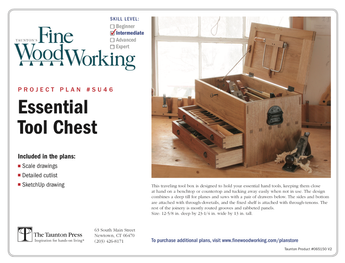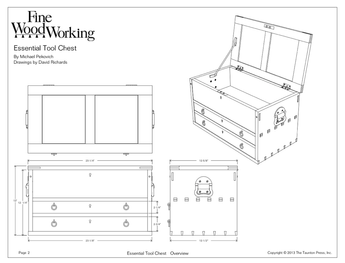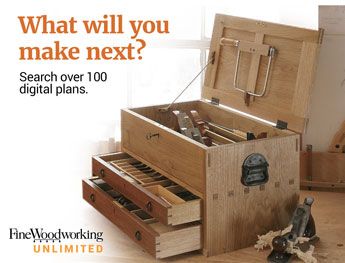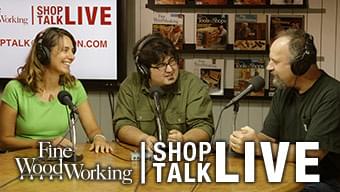I was thinking about getting a rip saw and thought I might get a Disston…in checking prices, I ‘ve found the Disston 12 to be more expensive than saws by my favorite contemporary makers. What makes that saw so expensive (besides the obvious, ie people willing to pay the price)? rarity or was it that well made?
Neil















Replies
Way to go !
I am no use to you as I cannot answer your question ( though I look forward to reading what others will say ). What I want to communicate is my gratitude for helping get this forum turned back toward fine woodworking topics and away from all the rat holes we have fallen into of late: forum problems/complaints, religion, who is hitch hiking to what action hot spot in what part of the galaxy . . .
: )
Seriously though,
Good going !
rat holes
well,
I was going to bring up Scientology but then thought better of it...don't think old Henry was a Hubbard follower...
There is nothing like a vintage Disston saw. Check this website for some great information.
http://www.disstonianinstitute.com/
Neil,
Have a few dozen (okay, more than a few) Disston handsaws, I can say the answer can be about whatever you want it to be. And most would be truthful. (If you already know what I am about to say, please forgive me.)
Someone referred you to the DisstonianInstitute I believe. Great source of information. The #12, and 2 or 3 others, are considered to be made of the best steel of their day. Some would say still one of the best. Some would say Disston figured out how to make the steel great as well as how to form and shape it as thin as was done.
Find a copy of the video (tape or disc) of Tom Law teaching you to sharpen a saw. Tom is retired from saw sharpening but he probably is one of the top 2 or 3 individuals with as many years of full time saw sharpening as one could have and still be alive.
If you live in central PA I would be glad to sell you some saws cheap. Regardless, get one, or more, that is not as collectable as 12s (in almost any condition) and use it to practice your jointing, setting, and sharpening skills. As well as restoring an old rusty saw. It is such a joy to use a saw that you have restored to usability and good (not new) looks. You can then appreciate even more so a new Independence Saw (Lie Nielsen) or Wenzloff or one of the others made today.
I, although not being a steel expert, would disagree that a cheap saw today is equal to Disston's steel. A couple of my first saws were inexpensive modern day saws sold at recognized woodworking dealers. Such poor performers I returned them. Started learning to restore, joint, set, sharpen handsaws. Hence the beginning of a "collection."
Even learned to make "new" handles that are the size and shape of the originals.
Whatever you do, have fun. Makes learning a whole lot easier.
Alan - planesaw
Passing on opinions
I read on the website of David Savage, the man in England who makes the very curvy chairs that despite his love of old saws, he really thought they didn't preform as well as the cheap new variety you can find. I believe you can find his advice about saws in his comments about hand tools.
Have you considered buying a bow saw instead. There have been several features about them recently, not that they are a very cheap alternative.
Peter
Neil,
According to my 1936 Disston catalog, their D-15 and D-115 were their top of the line saws back then. They boasted rosewood handles, and nickel-plated screws. Other saws in the line, the D-8, D-12, and D-23, had applewood handles and brass screws. The D-7 had a beech handle, and brass screws, and shows the least amount of factory engraving on the blade.. All were, in the words of the catalog, "made from the famous Disston steel."
As far as cost, in my experience, handsaws are still one of the cheapest of old tools on the market. They can frequently be had at yard sales or country auctions for under $10, and antique shops around here will have them, all shined up and ready to hang over the mantel for 25 bucks or so.
Around here (Va's Shenandoah Valley) the d-8's seem the most common, used by house carpenters and farmers, followed by D-12's. I have two D-15's, both used by furniture craftsmen, both "Liberty Bell" models. Interestingly, one of these has a plywood handle, not rosewood. It's factory engraving leads me to think it was made during or just after WWII, and I'm guessing Rosewood wasn't available just then. The rosewood handled saw is older, I believe. It was owned by the late local furniture guru Carlyle Lynch. It came up for sale at a local auction house, and I was determined to get it at any cost, just because of its provenance. Cost me $25, the most expensive handsaw I ever bought.
If I were in the market for a handsaw, I'd scour the flea markets and antique shops for an old (pre 70's) user. I wouldn't worry too much about the model #, they are all pretty good saws. If the handle is not broken loose or missing screws, and the blade isn't kinked, and there isn't any rust pitting on the blade near the teeth, just file it up and go to work.
Ray
I'm Jealous
Saw owned by Carlyle Lynch in your collection.
Very cool.
roc,
It was my good fortune to have met Mr Lynch early on in my woodworking career. I was working at Va Craftsmen in Harrisonburg (now defunct) where years before, he had been the draftsman, making blueprints and working drawings of the pieces they built there. After he'd left the company to teach industrial arts at a local high school, he still returned to the shop from time to time, and I made his acquaintance at that time (1971). As time passed, he was kind enough to welcome me (and other young fellas) to his home and shop, sharing bits of woodworking lore and stories, and asking us from time to time to "prove" his drawings (he was marketing his prints at that time) by building the pieces therein.
Carlyle Lynch was our grand old man of woodworking, an old time southern gentleman, free with his time and advice to a beginning craftsman. One visit to his home culminated with us listening to a recording of Hal Holbrook as "Mark Twain Tonight"- "You haven't heard this? Well, it's just worth listening to right now." Another call resulted in meeting the inimitable George Frank, of "Adventures in Woodfinishing" fame- I arrived at the Lynch home to see Mr Frank up to his elbows in the kitchen sink making a "brew noir" of walnut hulls. The old boy looked and talked just like inspector Poirot. "Zeeze walnut hulls, zey are not quite, how you say, of zee corrrect rrripeness."
I found Carlyle to be warm and congenial, with an old-fashioned wittiness. He once handed me a Chippendale looking glass to look over with the quip, "See the monkey?" His former industrial arts students, however, tell stories of an irascible teacher who jealously guarded the integrity of the hand tools in the shop at school.
Geezing over now,
Ray
Stories
Nice stories Ray! 25 dollars for that saw is a bargain for the priceless memory and enjoyment of using it with all the history behind it. I enjoy using my Dad's D-23 as well. Thanks for geezing.
My thought on handsaws... just like any other tool, if it is not sharp it's just an ornament.
Morgan
Disston 12
Thanks to everyone for their input so far. As usual I've learned alot although my original question concerning the value of a # 12 wasn't really answered. I'm guessing that rarity plays the biggest part. Mel used that mysterious phrase "overly rich" again...he never really defined it the last time I asked...I'm guessing it is kinda like my father's definition of an alcoholic "anyone who drinks more than the doctor"....overly rich is like overly beautiful, overly healthy, overly smart...I guess I wouldn't mind being any of those things.....oh damn, Mel's managed to bait me again....
Neil
fly fishing
Mel casts these flies out onto the water and then waits. Once he senses a nibble, he gently sets the hook and we don't even feel a "pinch" (as the nurse iwth the needle would say). ;-)
Your Right Ralph
Lets have a contest to describe Mel ,,, You gotta love the guy .
To me Mel has the never ending energy and tenacity of a Young Bird Dog , always ready to please .
Mel has stirred so much conversation good bad and indifferent , this place has been kept on our toes by Mel .
regards , dusty
Hi Morgan,
My dad gave me a brand new D-23 in 1971 when I was just starting out. At that time, it was Disston's top of the line handsaw. First thing I did was strip off the shiney lacquer finish and reshape its sharp-cornered handle.
Old timers used to assess the quality of a saw by how well it would "ring". Most any saw will sing when it is pushed into a slight "S" curve, and tapped, making a musical tone. But if you find the sweet spot, you can hold the saw horizontally by its handle and gently tap the blade with your fingernail about 1/3 the way back from its tip, and maintain contact, and the blade will gently ring with a faint bell-like tone. Those old Liberty Bell Disstons will ring for several seconds; the D-8's I have, kinda go "plink". Way they are handled, or quality of the steel? I dunno, but Lloyd Kiser, an old boy I used to work with,( the original owner of my laminated handle Liberty Bell saw,) had a Montgomery Ward panel saw that would do the same thing. He'd tap that little saw's blade and cock his head. "Hear that?" he'd ask. "That's a good saw!"
At Lloyd's sale, I got the Disston, the Ward's saw, and the toolbox they were kept in, that sat on Lloyd's bench at Va Craftsmen. It seemed a shame to not keep them together.
Ray
Singing in the shop...
Hey Ray,
I have always enjoyed making that D-23 of my dads sing, but always did it by curving the blade. Funny how some sing better than others, you can milk the sound by carefully changing the flex. I have another old Diston i picked up but never cleaned up. It sings better yet. However it is a clunker in your Plink test as well. I have a hunch it might be how well the handle fits to the steel. A bit sloppy in the fit or loose and it might dampen the haromonic vibrations?
Nice, a boxed set of tools, and bought by the guy who knows their real worth.
Morgan
Morgan,
Love the sound of a musical saw. Haunting. The image of the big chief loping across the grounds of the hospital in One Flew Over the Cuckoo's Nest come to mind.
I suspect that the fit of the handle has an effect at the very least, on the plink test. The better saws, supposedly, are the ones with 5 screws, rather than 4 holding the handle to the blade.
Who knows, though? Maybe there actually is something to the mfrs hype about the quality of their proprietary steel process? Even tho the ones "Warranted Superior" frequently are the inferior ones.
Haha.
Ray
Memoires ? Oh yes please !
George Frank and Carlyle Lynch visits. I never realized. It seems important to write up or dictate those memories for us newbies. Have you published anything like that ? Of course I have read "Adventures in Wood Finishing" by Mr Frank and a few articles by Mr Lynch but I for one am hungry for all I can find about that time period, 1920s through'70s, and those craftspeople.
roc,
"Woodworking
roc,
"Woodworking Celebrities I have Known". That would be a short article. I think I just wrote it, see above.
OTOH, I myself am a footnote in a doctoral thesis which is a footnote in one of Scott Landes' books. Does that count as celebrity?
On a more serious note, and completely off topic, I am sometimes made aware of a certain continuity that I am perpetuating in my own little way by passing along such of "the art and mystery" of the craft as I can, that has been handed along to me. The tools themselves, some of them a hundred or more years old, that I have acquired, are part of that continuum. I don't often give them out, however!
Ray
Disston 12
http://www.disstonianinstitute.com/12page.html
After over 40 years of using hand saws, I've found that nothing compares with a vintage Sandvik
This forum post is now archived. Commenting has been disabled